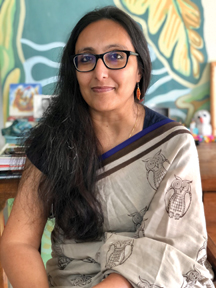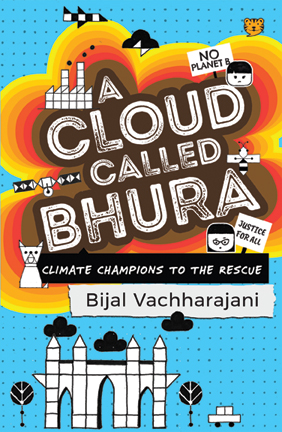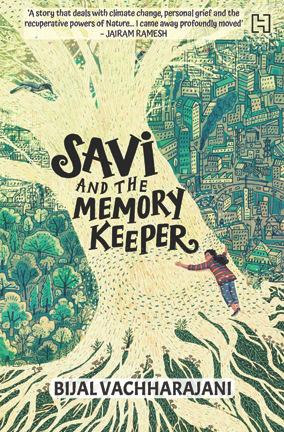Chintan Girish Modi

Bijal Vachharajani has one of the most exciting jobs in the world. She is a commissioning editor at Pratham Books, which means that she gets to dream up picture books for children and also bring them to life in collaboration with writers, illustrators, and designers. The job gives her plenty of time to write her own books, hug trees, talk to caterpillars, and crack hilarious jokes.
If you haven’t encountered her writing yet, start with any of her books. What’s Neema Eating Today? (Pratham Books, 2016) is about discovering the beauty of each season, along with some seasonal produce. So You Want to Know About the Environment? (Rupa Publications, 2017) touches upon topics like climate change, food wastage, planned obsolescence and recycling, without boring readers to death. The Seed Savers (Pratham Books, 2018) revolves around a seed bank run by farmers to protect local and organic seeds that do not need chemicals to grow.
Wait, there’s more! Her book A Cloud Called Bhura (Talking Cub, 2019) tells the story of a city under siege thanks to a “very angry, very brown and very dangerous cloud” while PS. What’s Up with the Climate? (Pratham Books, 2020) looks at the impact of climate change on the habitats of different species. Savi and the Memory Keeper (Hachette India, 2021) is about healing from grief by unlocking the secrets of plants and trees, whereas Kitten Trouble (Duckbill Books, 2021) narrates the adventures of a girl who is terrified of animals but her mother brings home a kitten.

If this impressive list has not done enough to highlight Vachharajani’s amazing repertoire, check out the books that she has co-authored. One of these is The Great Indian Nature Trail with Uncle Bikky (WWF India, 2019), written with Rohan Chakravarty. Another is 10 Indian Champions Who are Fighting to Save the Planet, written with Radha Rangarajan (Duckbill Books, 2020). The most recent is Earth, Our Home: Poems of Climate Change (Pratham Books, 2021), written with Karthika Nair, Salil Chaturvedi, Anushka Ravishankar and Sampurna Chattarji.
When Vachharajani was pursuing her Masters in Environment Security and Peace at the University for Peace in Costa Rica, she had no clue that one day she would write children’s books on these subjects. On a Zoom call, she tells me, “Before my first book came out, if anyone had told me that I would be a children’s book author, I would have said,‘You’re joking, right?’ Even now, I hold the space in a lot of awe because children’s books have influenced me deeply.”
She remembers signing up for a class on Education for Sustainable Development (ESD) at the university. “The professor spoke to us about how environmental education was becoming core to every curriculum designed in the United Kingdom and in other parts of the world. My mind was blown away by the idea. I was pretty sure that I would get a job in that area,” she says. Sadly, it did not happen because, “in 2013, there were fewer people who took climate change seriously.”
Those who associate Vachharajani primarily with children’s literature may not be aware of the fact that she was an editor at Time Out Bengaluru. She has also worked in the field of advocacy with Sanctuary Asia, People for the Ethical Treatment of Animals (PETA), and Fairtrade Asia Pacific.
Her books owe much to what she learnt from these organizations but what is most striking about them is that they are neither angry nor alarmist. They crackle with humour and greet you with generous helpings of hope. This approach is different from the one prevalent in spaces of activism and policy making – grounded in fear and self-preservation rather than love for nature.
Vachharajani tells me, “A lot of research shows that when you show human beings messaging that is negative, especially about climate, they tend to switch off because they wash their hands off it. They feel that nothing can be done.” She believes that David Attenborough’s documentaries on climate change are popular because “he shows you what’s beautiful and what’s at stake.” She adds, “First, you’ve just got to have children going out into the wild, or being with a tree in their neighbourhood. That’s how they fall in love; they don’t see nature as separate.”

This explains some of the metaphors, analogies, and similes in her books. Do not be surprised if you meet someone who feels small and ignored “like a dung beetle” or if you come across “a look that would have melted polar caps if they had not already been melting.” None of these expressions sound forced. Vachharajani writes like this because of how she relates to species other than human beings. Such an intimate relationship cannot be crafted through words alone.
Nature has been very much a part of her life because of her mother, “who observed things around her and shared them, who also brought home lost kittens and took care of them, or found the mother cat, or got the kittens adopted.” Speaking of the language in particular, she says, “I think it’s very hard for me to not think in those terms. Sometimes I don’t know how to deal with the damage that we humans have caused, so I focus on the little things, which are magical to me.”
Vachharajani points me to an idea that struck her when she read environmentalist David Orr’s book Ecological Literacy: Education and the Transition to a Postmodern World (1992). According to Orr, “all education is environmental education.” He writes, “By what is included or excluded, emphasized or ignored, students learn that they are a part of or apart from the natural world. Through all education we inculcate the ideas of careful stewardship or carelessness.”
The author is a Mumbai-based journalist who loves reading children’s books. He can be reached at chintan.prajnya@gmail.com.
